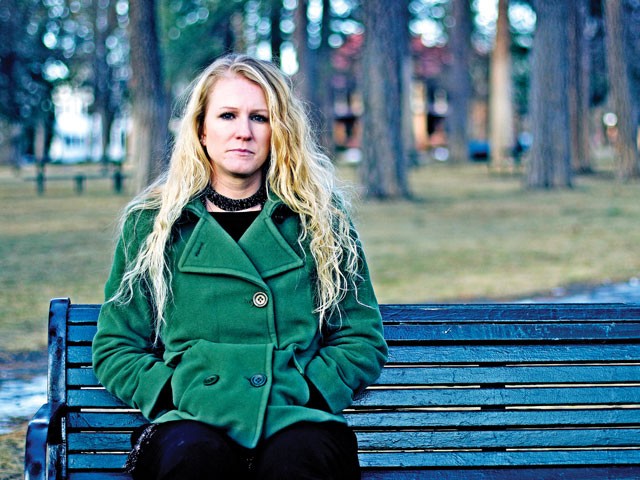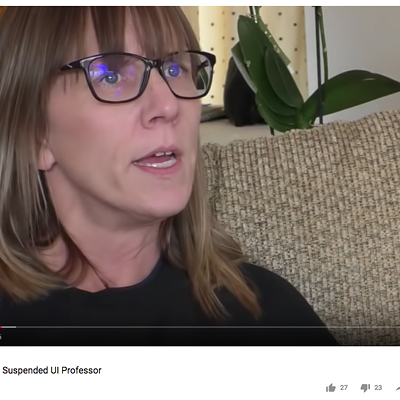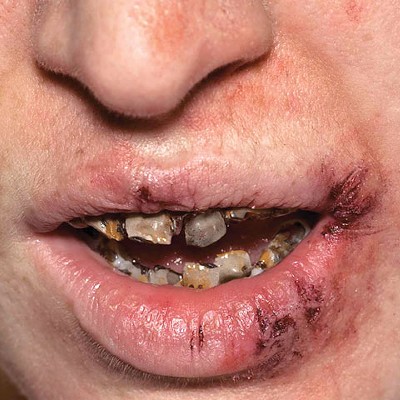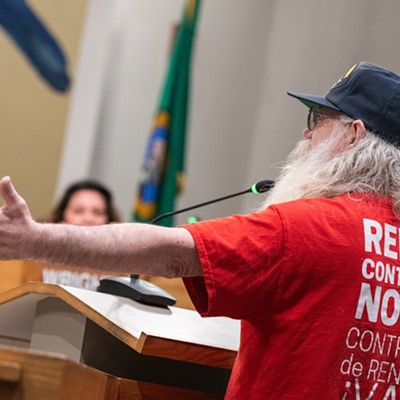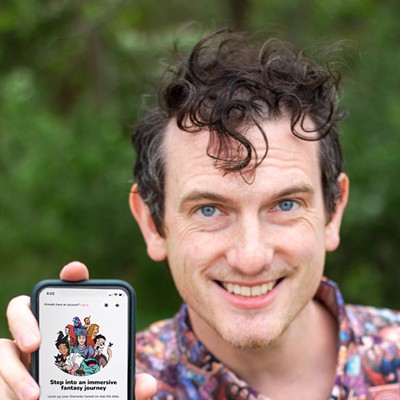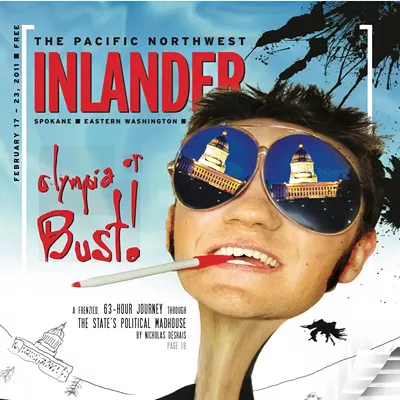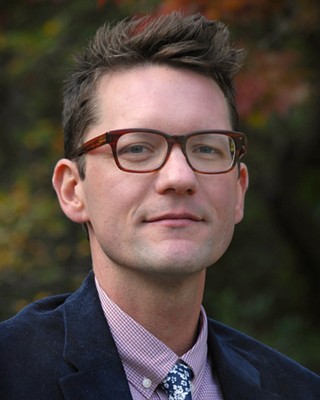Lacey Jones was sliding. A sophomore at Whitworth, Jones had transferred from Washington State to play softball, the sport she loved. She was practicing sliding one day in February 2002, gliding over the grass again and again, when her metal cleats dug into the turf and her ankle popped. The doctor told her it was broken, cast it and gave her Vicodin, a commonly prescribed narcotic.
“It helped my pain, [but] I didn’t even really like the feeling that [the pills] gave me,” Jones says. “After awhile, I started to like that feeling. So I just kept taking them. My body got used to taking them, my brain got used to that feeling. It got to a point where I needed them just to feel normal.”
Two years later, Jones found herself on another field of grass, in Coeur d’Alene Park near downtown Spokane, with her dogs, Teeny and Tiny. An older homeless man named Fuzzy approached.
“You know anybody that wants to buy some methadone?” he asked her.
“I was severely addicted at that point, and so I said, ‘Oh, sure!’ He became my best bud. It wasn’t safe, I’m sure,” Jones says. “Who knows who that guy was? I was spending all my money on pills. I would break into people’s houses when they weren’t home because I knew they had pills. Every waking moment was in search of more pills. It was an exhausting lifestyle.”
Jones is lucky. She survived. Not everyone’s so fortunate.
It’s an all-too-common remedy in our society: magic pills for every imaginable ailment. Increasingly, though, the pills often do more harm than good.
Prescribed by a doctor, made in a sterile lab and approved by the federal government, pain medication has become something once reserved for the street corner: a highly addictive drug that users will do anything to obtain. Crime is up, solutions are elusive and, most importantly, more and more people are dying.
In 1999, five people in Spokane County died from accidental prescription drug overdoses. In 2008, that number jumped twenty-fold, to 100.
“It’s a huge problem. The whole drug overdose death issue has changed so dramatically in the last 10 years.” says Dr. Sally Aiken, a medical examiner for the county. “When I came [to Spokane] 10 years ago, the deaths — there weren’t as many of them — but they were almost all heroin, and maybe some cocaine, and maybe some heroin plus cocaine. Now, I don’t see very many deaths like that. Mostly, it’s all prescription medications.”
The autopsy room for Spokane County is housed in Holy Family Hospital. Gleaming with stainless steel and decorated with diagrams of the human body, this room sees as many as 600 bodies a year.
Some bodies don’t hide their secrets from Dr. Aiken. There are the bullet wounds, the abrasions from a hanging, or the telltale signs of a car accident.
But some, at first, are mysteries. “The ones where we wait for toxicology to come back, we have to wait,” she says. “There’s not a way we can look and say, ‘There’s going to be a positive or negative for this or that or whatever.’” This or that or whatever, says Aiken, usually ends up being methadone, oxycodone or hydrocodone.
In just eight years, between 1997 and 2005, the amount of five major painkillers sold at U.S. retail pharmacies rose 90 percent,according to Drug Enforcement Administration figures.
“Prescriptions are increasing,” says Aiken. “Between 1998 and 2006, prescriptions increased eight times for methadone. There’s a five-time increase in methadone deaths in the same time period. It’s much more available. ... It feels safe — people think because it’s a prescription it can’t hurt them. They don’t know thatthere’s not much difference between what can make you high and what can kill you.”
“People don’t appreciate how powerful they are. Consider the fact that OxyContin [the brand name of oxycodone] is generally 30 to 40 times more powerful than morphine, unit per unit,” says Rob McKenna, Washington state’s attorney general. “People who are abusing them are taking them in a way that makes them more dangerous. They’re grinding them up and swallowing them, or snorting them or injecting them. When you do that, you bypass the time-release mechanism — the safeties.”
In 2006, about 39,000 Americans died from drug-induced deaths. While motor vehicle crashes still kill more people every year — with 45,000 in 2006, it was still the No. 1 accidental killer in the nation — those rankings are quickly reversing, state by state.
In 2003, eight states had more drug-induced deaths than car crashes. In 2006, it went up to 16 states. Washington’s drug deaths outpaced car accidents for the first time in 2004, when 695 Washingtonians overdosed and car wrecks killed 679.
Methadone, once used exclusively to treat heroin addiction, now accounts for the majority of overdoses, thanks to its reclassification earlier this decade as an “analgesic,” meaning a painkiller.
“If anything, we probably underestimate the number of prescription drug overdoses because not every case gets autopsied. Not every case gets toxicology done,” says Dr. Robert West, Kootenai County’s coroner.
In 2006, West performed 11 autopsies that revealed prescription drug abuse. In 2009, he did 15.
“This is a real problem,” he says. “In the last 10 years, there’s been a real significant growth in prescription drug overdose deaths. It’s pretty much all OxyContin.”
Back in Spokane, Aiken’s not sure when the deaths will plateau.
“It looks like we’re on the same bar,” Aiken says about the numbers from 2009, which should be published in the next couple of months. “It doesn’t look like it declined. It might have leveled off, but I thought that last year, too, and we actually increased.”
Ken Zigler remembers the last time he spoke with his 17-year-old son.
Tim, a junior at Spokane’s Ferris High School, was home late from his job at the Spokane Valley Mall one Sunday night in March 2006. He took a shower and told his dad he was going to bed with a headache and some chest pain.
“I went down there to talk to him for a while,” Zigler says. “I said, ‘OK, Tim. I’ll check on you in the morning, see how you’re feeling.’” The next morning around 6:30, Zigler went down to check on his son before his alarm went off. Heading into the dark basement, he heard Tim snoring loudly, and breathing very deeply.
“I said, ‘Tim!’ Trying to wake him up. Couldn’t wake him up,” Zigler says. “I turn the light on, looking at him. His face and his lips had already turned really blue, so I knew he wasn’t getting oxygen. … I called 911. They told me, ‘Get him down on the floor. Start CPR.’ … Tried to clear his passageway but it was clear. His lungs were shutting down. He took his last breath right when the fire department walked through the door.”
At the hospital, Zigler took the earring out of his son’s ear and collected the rings from his fingers. The nurse told him Tim had methadone in his system. (This was later confirmed by the autopsy report.)
“We thought, ‘What’s methadone?’” Zigler says.
“Never even heard of it. Didn’t have a clue what it was.”
Since then, Zigler’s learned. Methadone is a narcotic painkiller similar to morphine. Its half-life is much longer than other narcotics, and it can stay in a person’s system days after that person no longer feels its more euphoric effects. By itself, and when combined with other opiates, it can slow a person’s breathing to fatal levels.
Tim got the methadone pill from a 15-year-old classmate.
“Tim’s death was just uncalled for,” Zigler says. “How many times have we done stupid things at 17 years old? He didn’t really deserve to die because he took a couple pills.”
In these four years, Zigler has shared the things he’s learned. “I’ve gone up to people in the grocery store. I’ve even gone up to the kids skateboarding in the street. It’s like I have no fear anymore.” Through the Greater Spokane Substance Abuse Council, he’s spoken to 38 groups — schools, neighborhood groups, nurses — to tell them about Tim.
“The only way I can justify his death is to do something good out of it,” Zigler says. “I have to turn it into a good thing. Because to not do anything would be tragic. At least if I turn it into something good, I can think that I’m helping somebody.”
Help isn’t exactly on the way from the law. “There’s really not much we can do,” says Bill Beeman, a sergeant in the Spokane County Sheriff’s Offi ce Major Crimes Unit. “They are all drugs that are FDA-approved. Doctors prescribe them to their patients. You don’t know if it’sa situation where a person has a pain or an ailment [or is abusing them].”
“It’s a complex problem, because there is no single culprit,” says McKenna, the attorney general. “It’s not like meth where you can say, ‘Oh, it’s the meth cooks and it’s the drug-trafficking organization.’ First of all, of course, prescription drugs are not illegal in the first instance. We’re talking about drugs that are diverted from proper use.”
Besides the complexity of the issue, says Sgt. Dave Reagan, spokesman for the Spokane County Sheriff’s Office, there are too few resources to do anything. “We’re running out of bodies to enforce the law,” Reagan says. “If they’re not selling hydrocodone to third-graders, they probably have nothing to worry about. We’re chasing the people with the guns. Our hands are full with heroin and cocaine and those types of drugs.”
Which brings up the question: When does someone’s addiction become society’s problem?
“There’s a fine line there,” says Dr. Michael Lemberger, who ran an opioid treatment program at Rockwood Clinic before his retirement. “You’re an addict when you start doing devious things to get your drug. It destroys your life, your family, your job. Then you’re an addict. If you’re dependent but you can control it enough and afford it, if you’re not doing criminal activities and you’re maintaining your life, then you’re dependent. There are people who spend thousands and thousands of dollars a month and they’ve got a good job. They can get away with it — for a while. You can’t keep doing that forever. That’s the catch. Eventually, it’ll catch up to you. It’s a house of cards.”
“You can’t trust an addict,” says Jerry Fougere, clinical director at Lakeside Recovery Centers of Spokane. “Once they get a craving, they’ll do anything. It’s the insanity of addiction. First is deception. They’ll hide it from friends, family. Then they’ll start stealing. It progresses. The seriousness of the crime goes up with the severity of the addiction.”
Prescription drug-related crime has surged over the last few years. “We’ve seen a significant jump in pharmacy robberies,” Sgt. Beeman says. “There’s a market for it. People steal it to sell it. They use part of it, they sell part of it.”
According to the Spokesman-Review, there were 19 pharmacies robbed in the Inland Northwest in 2008, 17 of those for OxyContin. And earlier this year, Walgreens installed special time-locked safes only in its Washington stores. Assistant U.S. Attorney Ron Friedman, who has focused on drug prescription cases since 2005, was quoted last year as saying that pharmacy robberies in Washington state have increased by 25 percent since 2007.
“It by far exceeds the surrounding states of Oregon, Idaho and Alaska,” he said.
“It’s an incredible problem. And it’s all under the surface,” says Lemberger. “All you hear about are the robberies at the Walgreens, but for each one of those there are hundreds and hundreds of people that are just scrambling to get this drug. Everyday. It’s an incredible public health problem.”
Within three weeks of first trying OxyContin, Jason had one priority: getting more Oxy.
Jason, who spoke on the condition that his last name be withheld, is as normal-looking as they come. He grew up a clean-cut kid — a good student from a good family in Spokane. He attended the now defunct Dynamic Christian Academy and went off to Spokane Falls Community College a year early. He was going to be a high school math teacher.
The first summer out of high school, he smoked pot for the first time and he liked it. He played drums, many times at his church’s worship center, and just coasted along for a few years — mildly partying and being very involved in his church.
Then he got a job selling phones out in the Valley. On his first day, he struck up a conversation with a co-worker.
“Drugs came up,” Jason says. “I told him that I smoked pot, whatever.” His co-worker offered him some OxyContin, an eighth of an 80-milligram pill.
“I liked how it wasn’t so overwhelming that I couldn’t work. I just felt laid-back. I wasn’t focused on my problems, things of that nature,” he says. “Everything seemed like more fun.”
Jason took it everyday for the next three weeks and developed a routine. He’d crush it, snort it and “play online pool for hours, hours, hours. And it was just so much fun. I didn’t realize how wrapped into it I was until the first time it wasn’t available and I got sick.” He couldn’t sleep. It felt like his “central nervous system was exploding. Up and down my spinal cord would be shocks, just spasms.”
After his first withdrawal, he didn’t let himself run out again, and a year later a friend of a friend showed him a new way to get high — with the same drug, but with a needle in his vein.
Soon, he had abscesses and bruises up and down his arm. By shooting up, he had doubled his usage. Every day, he says, he’d shoot somewhere between 160mg and 600mg — the equivalent of up to 30 pills.
His parents found out and sent him to a residential rehab center in Kirkland. Three months after coming home, he started using again. He never shot up again, but he kept himself high. He cycled through narcotics: oxycodone, heroin, methadone. He lost his job and had trouble staying afloat.
Then he met a doctor who prescribed methadone.
For two years, the doctor kept him on methadone and Jason hoped to wean himself. Then the doctor was shut down by the DEA.
On his way out, the doctor had prescribed Xanax to help Jason get through the withdrawals that would eventually come. One night, Jason popped a bunch and left the house. He drove — he can’t remember why, exactly — and got really tired. He pulled over and went to sleep. He woke up, got out of the car and accidentally locked himself out. He smashed the window, crawled back in and fell asleep again. Next time he awoke, a cop was tapping his shoulder. Jason had a pot pipe and the Xanax on him. He went to jail.
He had hit rock-bottom, and he had had enough.
He became a patient at the county’s methadone clinic, where he’s been for the last year and a half. He says it saved his life. With his daily visits and the counseling, Jason has a found rhythm on which he can rely. (The methadone pills found on the street don’t come from the clinic, which supplies its medicine in liquid form that must be ingested on the premises.)
Jason is a year away from getting an accounting degree from Eastern Washington University. But he’s still cautious.
“I just don’t want to put myself in a frantic situation that would make me do anything but finish school,” he says. “That’s my goal. Anything less is unacceptable.”
Jerry Fougere — who has seen the dramatic increase in prescription drug abuse firsthand at Lakeside Recovery — says there’s only one solution to lowering the number of dead addicts: education.
“We’re under-informed, including the medical profession. They believed [these drugs] was safe,” he says. “If we get the correct information out there, humans will make better decisions.”
As a society, we must begin, says Fougere, by being honest about other legal — and occasionally lethal — drugs: alcohol and tobacco. “We need to go to the root causes of addiction. … We market [alcohol], this psychoactive addictive substance, as a beverage. … For someone who’s vulnerable to being addicted, that’s where it all begins.”
For those people, addiction progresses, sometimes to prescription drugs. “There is nothing in nature that’ll make you feel like Oxy will,” Fougere says.
Fougere dismisses many chemical treatments such as methadone as being too simplistic, but he says drugs like Suboxone may offer some help in treating addicts.
“They say Suboxone is the silver bullet,” he says. His clinic works with a doctor who prescribes Suboxone. “They said that about methadone, too. Personally, I don’t think there’ll be a pill to fix this. Addiction is just too complex. But I am hopeful about [Suboxone].”
Dr. Lemberger, who ran Rockwood’s Suboxone clinic until he retired a couple of years ago, sees it a bit differently.
“The beauty of this drug is it has a ceiling effect,” he says. “The more take you take, it has less and less of an effect, until you can keep taking as much as you want and it does nothing. Nothing. You can’t overdose on it.”
Another difference between the Suboxone and methadone is the price. A prescription for Suboxone costs about $400 per month, depending on the dose. For the same price, at the county’s methadone clinic, a patient gets full treatment — methadone, doctor’s visits, therapy, urine analyses.
And though it sounds perfect, it’s not: Suboxone can kill you if it’s mixed with a non-opioid, such as Xanax.
Whether chemistry works or not, Attorney General McKenna sees a different solution, one that edges toward the deliberative. He’s formed a prescription drug abuse task force, which met for the first time last Friday, Jan. 15.
“Topic No. 1 for that task force,” McKenna says, “will be how to put together a prescription monitoring program — what it will look like, how it will operate, how it will get paid for.”
A monitoring program is something McKenna’s had his eye on for a while, and it’s something 40 other states use to track who’s buying these drugs, who’s prescribing them and where these drugs are going.
“We proposed [setting up a monitoring program] in 2007. We had a large legal settlement with Purdue Pharma, the makers of OxyContin. A chunk of that money, about $580,000, was appropriated by the state Legislature to the Department of Health to start building a prescription monitoring program.”
McKenna has repeatedly joined other states in lawsuits against pharmaceutical companies — companies like Bristol-Myers Squibb, Merck, Bayer and Pfizer — many times for “unfair and deceptive marketing practices.”
But the monitoring program was scuttled before it even took off because of budget constraints. Regardless of where the money will ultimately come from, McKenna seems resolved to find a solution.
“We are losing far more people to prescription drugs than we ever lost to meth,” he says. “Because these deaths occur quietly and are quietly reported, people have failed to grasp the magnitude of the problem.
That’s one of the reasons so many people die. They don’t understand. If there are huge headlines every time someone died of a drug overdose — not just Heath Ledger or Michael Jackson, but everyone, everyday people — people might become a lot more careful. But as it is, people just quietly pass away.”
Lacey Jones’ ankle has been healed for eight years, and it’s been eight years since she was given her first prescription for Vicodin.
Almost four years ago, scrambling for some pills, she went to the emergency room for a “headache” to get some heavy-duty painkillers. Her sister, Meg, saw the bill and asked why she went to the ER for a simple headache.
“At that point, it was like, ‘OK, Meg. I’ve got a really big problem,’” Jones says. For more than four years, Jones had kept her addiction from everyone — her friends, family, everyone. The same day her sister confronted her, Jones’ niece was born.
“I was in withdrawal when my niece was born — and that moment I saw her come into this world, I was like, ‘Oh, man. There’s more to life than getting high.’” Jones quit cold-turkey and has been clean since. She now works for the Greater Spokane Substance Abuse Council as a drug-awareness community organizer. She’s spoken to thousands of kids in the area. Yet she still thinks about the pills. Just three weeks ago, she had a craving.
“Why is this coming up three and a half years later?” she asks. “It’s always in your brain: ‘I could take one and nobody would know.’ But if I did take just one, I would be done for.”

